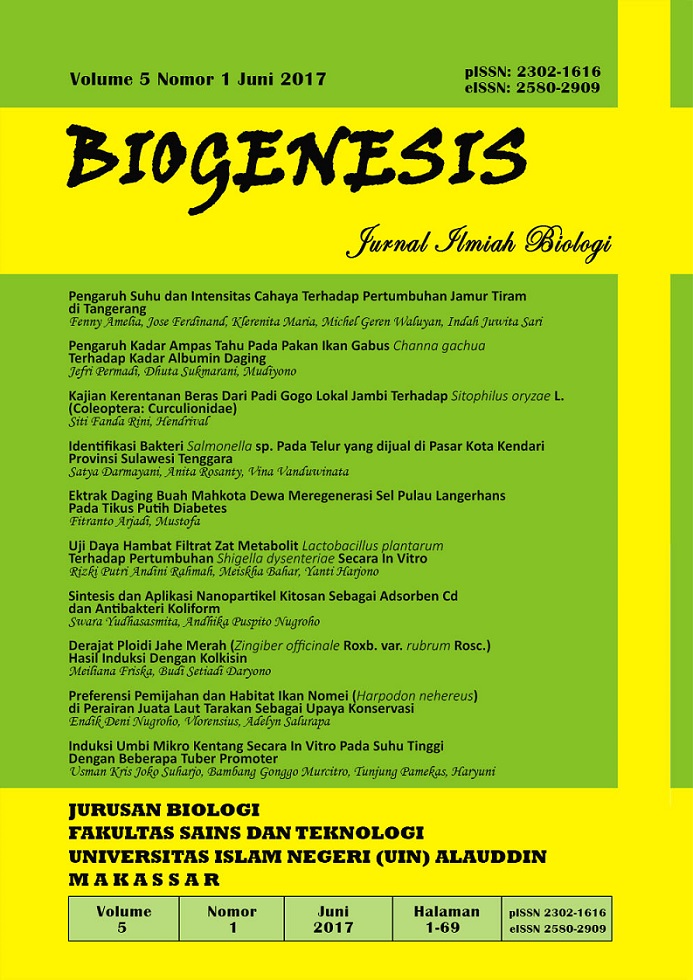Sintesis dan Aplikasi Nanopartikel Kitosan Sebagai Adsorben Cd dan Antibakteri Koliform
Abstract
Chitosan is a derivative compound of chitin which has a linear polysaccharide composed of β-(1–4)-linked d-glucosamine and N-acetyl-d-glucosamine. This compound is found in shrimp shell. In nanoparticle form, chitosan has a great antibacterial activity and adsorption ability rather than normal form. The aims of this study are to study the effect of concentration chitosan nanoparticle to adsorpt cadmium and its antibacterial effect on coliform. This research was started with synthesis of chitosan nanoparticles using acetic acid 2% and TPP 0,1 %, then the sampel was dried by spray dryer. For cadmium adsorption test was conducted by giving chitosan nanoparticle of 0.1, 0.2, 0.3, 0.4, and 0.5 g, respectively, into Cd solution with the concentration of 7 ppm and was filtered with theWhatman paper number 42 (n=3). Cadmium contents in the filtrates and pellets were analyzed by using AAS. For antibacterial test with Salmonella typhimurium andEscherichia coliwere conducted by disc diffusion method, contained of 0.1, 0.2, 0.3, 0.4, and 0.5 g, respectively, were dissolved in 50 ml of 1% acetic acid. Data were analyzed by using oneway ANOVA followed by LSD. Based on the results, the optimum adsorption of cadmium present in addition of 0.4 g/ 50mL, can reduce Cd concentration by 98,7%. For the antibacterial test, the addition of 0.4 g/50mL is the largest zone of inhibition Salmonella thypimuriumand Escherichia coli.
Copyright (c) 2017 Swara Yudhasasmita, Andhika Puspito Nugroho

This work is licensed under a Creative Commons Attribution 4.0 International License.
COPYRIGHT AND LICENSE STATEMENT
COPYRIGHT
Biogenesis: Jurnal Ilmiah Biologi is published under the terms of the Creative Commons Attribution license. Authors hold the copyright and retain publishing rights without restriction to their work. Users may read, download, copy, distribute, and print the work in any medium, provided the original work is properly cited.
LICENSE TO PUBLISH
1. License
The use of the article will be governed by the Creative Commons Attribution license as currently displayed on http://creativecommons.org/licenses/by/4.0.
2. Author’s Warranties
The author warrants that the article is original, written by stated author/s, has not been published before, contains no unlawful statements, does not infringe the rights of others, is subject to copyright that is vested exclusively in the author and free of any third party rights, and that any necessary written permissions to quote from other sources have been obtained by the author(s).
3. User Rights
Under the Creative Commons Attribution license, the users are free to download, reuse, reprint, modify, distribute and/or copy the content for any purpose, even commercially, as long as the original authors and source are cited. No permission is required from the authors or the publishers.
4. Co-Authorship
If the article was prepared jointly with other authors, the corresponding author warrants that he/she has been authorized by all co-authors, and agrees to inform his/her co-authors of the terms of this statement.
5. Miscellaneous
Biogenesis: Jurnal Ilmiah Biologi may conform the article to a style of punctuation, spelling, capitalization, and usage that it deems appropriate. The author acknowledges that the article may be published so that it will be publicly accessible and such access will be free of charge for the readers.


